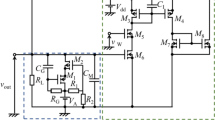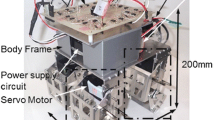Abstract
There is a lot of research on the application of artificial neural networks as a control method for robots to achieve bio-mimetic movements. In this paper, we have designed, fabricated, and measured a pulse-type hardware neural network that mimics spinal cord function. The model was able to change the pulse sequence, pulse width, and pulse frequency according to the input from a sensing model fabricated to mimic the pressure sensation of an organism. As a result, we have succeeded in developing an IC that can perform the same processing as the biological spinal cord. This makes it possible for a quadruped robot to not only change its gait but also to avoid danger by autonomously stopping its walking motion temporarily. The results show that this research has the potential to contribute to the realization of small robots with sophisticated and delicate movements, like living organisms.








Similar content being viewed by others
References
Kimura H (2001) Introduction to research on biological mobile robots using neural models (in Japanese). Jpn Neural Netw Soc 8(2):70–76
Grillner S (1981) Control of locomotion in bipeds, tetrapods and fish. In: Terjung R (ed) Handbook of physiology, vol II. American Physiological Society, Bethesda, pp 1179–1236
Ito K (1993) Gait movement and rhythm generation (in Japanese). J Robot Soc Jpn 11(3):320–325
Hodgkin A, Huxley A (1952) A quantitative description of membrane current and its application to conduction and excitation in nerve. J Physiol 117(4):500–544
Saeki K, and Sekine Y (1997) Pulse-type hardware neuron model with bursting firing phenomena. International Technical Conference on Circuits/Systems, Computers and Communications (ITC-CSCC) pp 435–438
Saeki K, Iidaka R, Sekine Y, Aihara K (2002) Hardware neuron models with CMOS for auditory neural networks. In: Proceedings of the 9th International Conference on Neural Information Processing, (ICONIP '02.) 3:1325–1329
Tanaka D, Uchiumi Y, Kawamura S, Takato M, Saito K, Uchikoba F (2017) Four-leg independent mechanism for MEMS microrobot. Artif Life Robot (AROB) 22(3):380–384
Kimura H, Akiyama S, Sakurama K (1999) Realization of dynamic walking and running of the quadruped using neural oscillator (in Japanese). Auton Robot 7:247–258
Saeki K, Tatebe T, Sekine Y (2012) A study on CPG model transition swing and stance pattern with interstitial cells. The 2012 International Joint Conference on Neural Networks (IJCNN)
Saeki K, Nihei D, Tatebe T, Sekine Y (2014) IC implementation of an interstitial cell-based CPG model. Analog Integr Circuit Signal Process 81:551–559
Hanba M (1973) Origin of small and short action potential elicited during the relative refractory period of nerve, (in Japanese). KITAKANTO Med J 23(6):407–419
Acknowledgements
This research is supported by Nihon University Robotics Society (NUROS) and supported by Nihon University Multidisciplinary Research Grant for (2020). The authors appreciate the support. In addition, this work is supported by VLSI Design and Education Center (VDEC), the University of Tokyo in collaboration with Synopsys, Inc., Cadence Design Systems, Inc. and Mentor Graphics, Inc. The VLSI chip (Fig. 5) in this study has been fabricated in the chip fabrication program of VLSI Design and Education Center (VDEC), the University of Tokyo in collaboration with On-Semiconductor Niigata, and Toppan Printing Corporation. We would like to express my deepest gratitude here.
Author information
Authors and Affiliations
Corresponding author
Additional information
Publisher's Note
Springer Nature remains neutral with regard to jurisdictional claims in published maps and institutional affiliations.
This work was presented in part at the 26th International Symposium on Artificial Life and Robotics (Online, January 21-23, 2021).
About this article
Cite this article
Hayakawa, M., Takeda, K., Ishibashi, M. et al. Pulse-type hardware neural network mimicking spinal cord function. Artif Life Robotics 26, 450–456 (2021). https://doi.org/10.1007/s10015-021-00691-1
Received:
Accepted:
Published:
Issue Date:
DOI: https://doi.org/10.1007/s10015-021-00691-1




